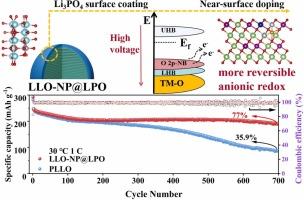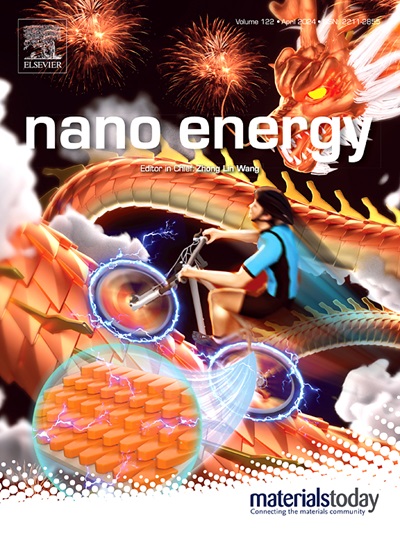基于原位表面重构的高性能锂离子电池富锂锰基正极材料氧化还原偶
IF 16.8
1区 材料科学
Q1 CHEMISTRY, PHYSICAL
引用次数: 0
摘要
富锂锰基层状氧化物(LLOs)由于其独特的阳离子和阴离子氧化还原对而产生的高容量,是一种很有前途的正极材料。然而,循环稳定性差和电压衰减剧烈阻碍了它们的实际应用。尽管提出了共价理论来理解LLOs的氧化还原活性,但仍然缺乏全面的设计指南。受聚阴离子阴极共价理论的启发,通过近表面掺杂和表面涂层的原位表面重建策略,开发了高性能的LLOs。密度泛函理论(DFT)计算表明,通过Ni2+和PO43-的引入,过渡金属(TM) 3d-O -2p和非成键O-2p的能带向较低能量转移,导致工作电位升高,晶格氧活度降低,氧化还原氧的可逆性增强。同时,Li3PO4涂层可以防止电解液的腐蚀,减轻LLOs在循环过程中的表面降解。结果,能力保留修改LLOs从35.9%上升到77%,与电压保留从68.6%提高到75.1%,700年周期在1 c。此外,在55摄氏度的能力保留修改LLOs也从32.1%升高到85.9%,保留从67.9%提高到82.3%,电压在1 c . 120次后提出的策略可以促进高性能LLOs和高能量密度锂离子电池的应用。本文章由计算机程序翻译,如有差异,请以英文原文为准。

Tailoring redox couples of Li-rich Mn-based cathode materials by in-situ surface reconstruction for high-performance lithium-ion batteries
Li-rich Mn-based layered oxides (LLOs) are promising cathode materials due to their high capacity derived from the unique cation and anion redox couples. However, the poor cycling stability and drastic voltage decay impede their practical application. Despite the covalency theory is proposed to understand the redox activity of LLOs, comprehensive design guidelines are still lacking. Inspired by the covalency theory of polyanion cathodes, high-performance LLOs are developed through an in-situ surface reconstruction strategy of near-surface doping and surface coating. Density function theory (DFT) calculations show that through the introduction of Ni2+ and PO43-, the energy bands of the transition metal (TM) 3d-O 2p and non-bonding O-2p shift to lower energy, resulting in the elevated working potential, reduced activity of lattice oxygen, and enhanced reversibility of redox oxygen. Meanwhile, the Li3PO4 coating can prevent electrolyte corrosion and mitigate surface degradation of LLOs upon cycling. As a result, the capacity retention of the modified LLOs is increased from 35.9 % to 77 %, and the voltage retention is raised from 68.6 % to 75.1 % after 700 cycles at 1 C. Furthermore, at 55 °C the capacity retention of the modified LLOs is also elevated from 32.1 % to 85.9 %, and the voltage retention is improved from 67.9 % to 82.3 % after 120 cycles at 1 C. The proposed strategy could advance the application of high-performance LLOs and their high-energy-density Li-ion batteries.
求助全文
通过发布文献求助,成功后即可免费获取论文全文。
去求助
来源期刊

Nano Energy
CHEMISTRY, PHYSICAL-NANOSCIENCE & NANOTECHNOLOGY
CiteScore
30.30
自引率
7.40%
发文量
1207
审稿时长
23 days
期刊介绍:
Nano Energy is a multidisciplinary, rapid-publication forum of original peer-reviewed contributions on the science and engineering of nanomaterials and nanodevices used in all forms of energy harvesting, conversion, storage, utilization and policy. Through its mixture of articles, reviews, communications, research news, and information on key developments, Nano Energy provides a comprehensive coverage of this exciting and dynamic field which joins nanoscience and nanotechnology with energy science. The journal is relevant to all those who are interested in nanomaterials solutions to the energy problem.
Nano Energy publishes original experimental and theoretical research on all aspects of energy-related research which utilizes nanomaterials and nanotechnology. Manuscripts of four types are considered: review articles which inform readers of the latest research and advances in energy science; rapid communications which feature exciting research breakthroughs in the field; full-length articles which report comprehensive research developments; and news and opinions which comment on topical issues or express views on the developments in related fields.
 求助内容:
求助内容: 应助结果提醒方式:
应助结果提醒方式:


